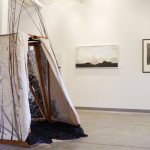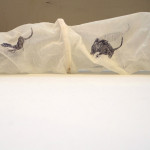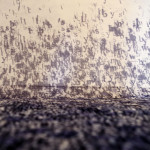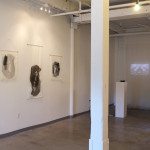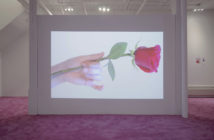Andrea Lynn Santos’ work evokes the spareness of this time of year, as leaves fall to the ground, windows are shut tight, and the sky is emptied of birds. As in the collograph print, My Bed, My Burden, it speaks to the desire to burrow under the covers and not emerge until spring Asylum, now on view at GRIN, might be too hard-edged a word for these rustic works on display. Santos’ work is softer, layered, delicate, in a minor key.
Asylum marks the first solo show for Santos, a 2011 Mass Art graduate recently relocated to Providence as an artist in residence at AS220. GRIN opened last summer by two fellow Mass Art graduates, Lindsey Stapleton and Corey Oberlander, in Providence’s burgeoning Olneyville neighborhood. Asylum's centerpiece is a sawed-off teepee-like construction: flaps of canvas upheld by branches of wood, the inner chamber mosaicked in cracked shards of mirrored glass. It is a site of mystical seclusion, set apart from the rhythms of everyday life. The structure is accompanied by a soundtrack by Nicholas DiSalvio, its moody tones providing just the sort of low-key ambiance for a winter of hibernation.
The exhibit offers the comfort of a nest, a certain snug homeyness, a refuge from a cold and wind-swept day. Running through it also is a sense of sadness and isolation. We feel the gradual and deliberate rotation of the seasons, of autumn moving into winter. We feel the accumulation of slow time, the seconds mounting like the hundreds of tiny drops etched in Weep. Like a prisoner’s tallies etched on the wall, Santos’ detailed and painstaking mark-making appears to be a ritualistic timekeeping, an almost meditative act carried out in isolation. She seems fascinated by the many minute parts that make up a whole: strands of hair, slivers of fur, the waves in the ocean.
"The cycles of repetition, flux, and reincarnation that occur while I’m producing prints are factors that resonate with me conceptually," Santos writes in her artist statement. She makes use of several different printmaking techniques from woodcuts and collagraphs to etchings and aquatints, the process itself mirroring the themes of layering, repetition, and accumulation. For example, in several of the works Santos uses the chine collé technique, in which thin sheets of paper are glued onto a thicker one, and passed through the printing press all at once.
Inspired by the natural world, with its neutral palette of beiges, browns, and grays, the work references cyclical processes of gestation and dormancy, the hidden growth belied by long periods of slumber. In Burrow, a triptych of woodcuts printed on hanging gossamer scrolls, two bears circle into one another, overlapping, becoming one, while another depicts a rabbit inside a larger animal’s stomach like Jonah in the belly of the whale. The circular motif, with its mythical overtones, is also seen in Passage, a delicate tube of paper printed with tiny mice who appear to be running in perpetuity. Although the monochromatic tone might leave some wanting for more excitement, the work maintains a taut equilibrium; it suggests a natural order of things, the transcendent and eternal, both changing and static at once.
- Andrea Lynn Santos, Asylum installation view. Photo courtesy of GRIN
- Andrea Lynn Santos, Asylum installation view. Photo courtesy of GRIN
- Andrea Lynn Santos, Asylum installation view. Photo courtesy of GRIN
- Andrea Lynn Santos, Asylum installation view. Photo courtesy of GRIN
Asylum closes today.


